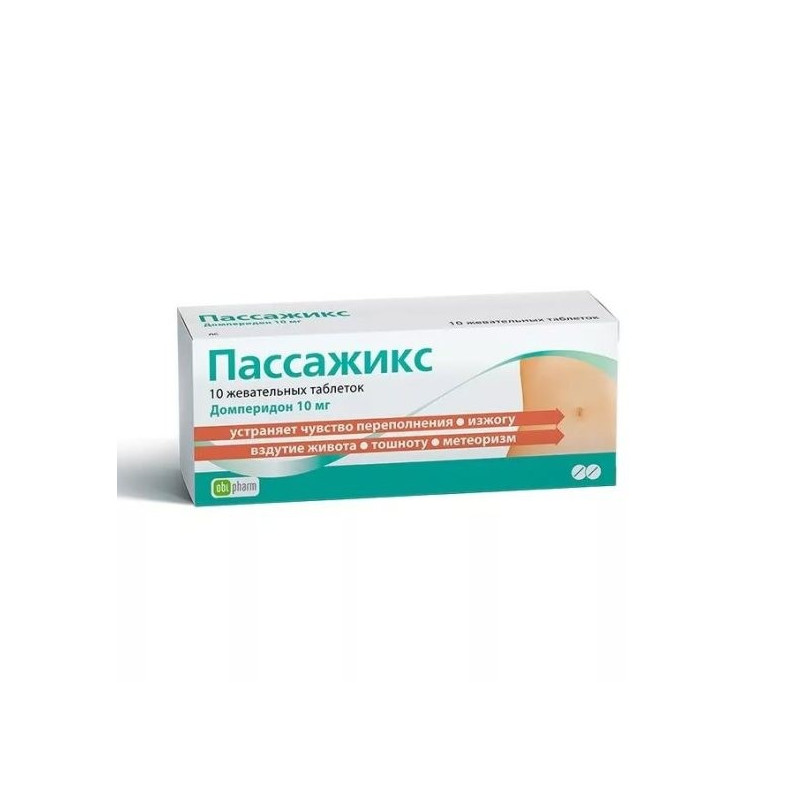



 All payments are encrypted via SSL
All payments are encrypted via SSL
 Full Refund if you haven't received your order
Full Refund if you haven't received your order
Domperidone
Active ingredient: Domperidone 10 mg;
Excipients: aspartame; lactitol; xylitol; Magnesium stearate; menthol
Passage - antiemetic.
Pharmacodynamics
Increases the duration of peristaltic contractions of the antrum and duodenum, accelerates gastric emptying in the case of slowing down this process, increases the tone of the lower esophageal sphincter, eliminates the development of nausea and vomiting.
Domperidone poorly penetrates the BBB (therefore, its use is rarely accompanied by extrapyramidal side effects, especially in adults), but stimulates the secretion of prolactin from the pituitary gland. Its antiemetic effect is probably due to a combination of peripheral (gastrokinetic) action and antagonism of dopamine receptors in the triggering chemoreceptor zone of the medulla oblongata. Domperidone has no effect on gastric secretion.
Pharmacokinetics
After taking the drug inside domperidone is rapidly absorbed.
It has low bioavailability (about 15%). Reducing the acidity of gastric juice reduces the absorption of domperidone. Cmax in plasma is achieved after 1 h.
Domperidone is widely distributed in various tissues, its concentration in brain tissues is low.Plasma protein binding is 91-93%.
Exposed to intensive metabolism in the intestinal wall and liver.
Excreted through the intestine (66%) and the kidneys (33%), in unchanged form, respectively, 10 and 1% of the dose is displayed. T1/2 - 7-9 hours, with severe renal failure, it is extended.
Do not use Passage when the stimulation of the motor function of the stomach can be dangerous, incl. with Gastrointestinal bleeding, mechanical obstruction or perforation.
With care: a renal / hepatic failure, the lactation period, pregnancy.
On the part of the digestive system: transient spasms of the intestine.
From the side of the central nervous system: extrapyramidal effects are observed in children and with increased permeability of the BBB. These phenomena are completely reversible and spontaneously disappear after cessation of treatment.
On the part of the endocrine system: the drug may induce an increase in plasma prolactin concentration, because the pituitary gland is outside the BBB. In rare cases, this hyperprolactinemia can stimulate the appearance of galactorrhea, gynecomastia and dysmenorrhea.
Allergic reactions: rash, urticaria.
With the simultaneous use of anticholinergic drugs can neutralize the effect of domperidone.
With simultaneous use with domperidone antacid drugs reduce its bioavailability.
Based on in vitro studies, it can be assumed that with simultaneous use of domperidone drugs that significantly inhibit the CYP3A4 isoenzyme (antifungal drugs of the azoles group, macrolide antibiotics, HIV protease inhibitors, nefazodone antidepressant), domperidone concentration in plasma can be increased.
The drug does not affect the concentration of Paracetamol and Digoxin in the blood. It is possible that domperidone may affect the absorption of simultaneously applied into the interior of drugs with a slow release of the active substance or coated with an enteric coating.
Inside, before a meal in 10-15 minutes.
Chronic dyspepsia : adults - 10 mg (1 tablet) 3 times a day, 15-30 minutes before meals and, if necessary, before bedtime; children over 5 years old - 2.5 mg (1/4 tablet) per 10 kg 3 times a day before meals and, if necessary, at bedtime.
Acute and subacute conditions (especially nausea and vomiting): adults - 20 mg (2 tablets) 3-4 times daily before meals and before bedtime; children over 5 years old - 5 mg (1/2 tablet) per 10 kg 3-4 times daily before meals and before bedtime.
For patients with renal insufficiency, dose adjustment is necessary; the frequency of administration should not exceed 1-2 times during the day.
The maximum daily intake for adults is 80 mg (8 tablets). The maximum daily dose for children should not exceed 10 mg (1 chewable tablet) per 10 kg.
Symptoms: drowsiness, disorientation and extrapyramidal reactions, especially in children.
Treatment: in case of overdose, the appointment of Activated carbon and careful monitoring are recommended. Anticholinergics, drugs used to treat parkinsonism, or antihistamines can be effective when extrapyramidal reactions occur.
With the combined use of the drug Passazhiks with antacid or antisecretory (m-cholinolytics, blockers H2-histamine receptors, proton pump inhibitors) with the latter should be taken after, not before meals, i.e. they should not be taken at the same time as Passazhiks.
Use in diseases of the liver. Given the metabolism of domperidone in the liver, it is necessary to carefully prescribe Passion to patients with hepatic insufficiency.
Application in diseases of the kidneys. In patients with severe renal insufficiency (serum creatinine> 6 mg / 100 ml, i.e.> 0.6 mmol / l) T1/2 Domperidone increased from 7.4 to 20.8 h, but plasma drug concentrations were lower than in healthy volunteers.Since a very small percentage of the drug is excreted by the kidneys unchanged, it is hardly necessary to correct a single dose in patients with renal insufficiency. However, when reappointment frequency should not exceed 1-2 times during the day, depending on the severity of insufficiency, it may also be necessary to reduce the dose. With long-term therapy, patients should be monitored regularly.
Influence on the ability to drive a car or other mechanical means. Domperidone does not affect the ability to drive vehicles and engage in other potentially dangerous activities that require high concentration of attention and speed of psychomotor reactions.
chewable tablets
In dry, the dark place at a temperature of no higher than 25 ° C
